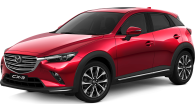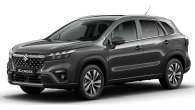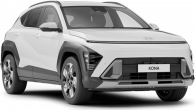The Renault Captur is stupendously, ridiculously popular… in Europe.
So popular, in fact, that it’s not quite enough to have just one Renault Captur, to they sell another one - a de-specified, Dacia-based Renault Kaptur – that looks exactly the same.
Bizarre. But then, the Captur is a bit bizarre. It’s as if it comes from an alternate dimension where style trumps practicality, and vibrant colours and tight dimensions are more important than, say, a cupholder.
The point is, in Australia at least, buying a French car tends to be a deliberate and not necessarily value-based choice. With so many keenly priced and well-specified Japanese and Korean competitors, a car like this requires a buyer who wants something genuinely different.
So, can the recently updated Captur appeal to buyers wanting something a little left of centre in one of Australia’s most hotly contested market segments, or does it play second-fiddle to the small SUV market leaders? I spent a week in one to find out.
Renault Captur 2019: Intens
| Engine Type | Turbo 4, 1.2L |
|---|---|
| Fuel Type | Premium Unleaded Petrol |
| Fuel Efficiency | 5.8L/100km (combined) |
| Seating | 5 |
| Price From | $19,030 - $24,090 |
Does it represent good value for the price? What features does it come with?
7 / 10
The Captur comes with some great features, some not-so great features, and a few notable omissions. Let’s have a look.
Our Intens is the top of a two-variant range. Coming in at $29,990 (MSRP), you’ll get 17-inch alloy wheels, a 7.0-inch multimedia touchscreen (with Android Auto, but oddly no Apple CarPlay…), built-in sat-nav, auto LED lights front and rear with cornering fog lights, a fixed panoramic sunroof, leather-trimmed seats, with heated front ones, leather-trimmed steering wheel, 360-degree parking sensors, a reversing camera, ‘park assist’ auto parking, keyless entry with push-start, single-zone climate control and an auto-dimming rear view mirror.
.jpg)
Not a bad set of equipment, but it’s also hardly a top-spec CX-3 or Hyundai Kona, which come with much more, albeit at a marginally higher price. It would be nice to at least see the inclusion of power-adjustable front seats.
Also, it’s incredibly confusing that this car doesn’t come with Apple CarPlay. It’s hardly excusable when it does come with Android Auto and, get this, the base model Zen gets a slightly different media system that does support Apple CarPlay at the cost of ‘enhanced’ built-in sat nav. Weird.
There’s no all-wheel-drive version of the Captur, and it’s also a bit light on active-safety items, which we’ll explore in the safety section of this review.
.jpg)
In its favour, the style items that the Captur comes with look fantastic. The two-tone colour scheme is standard on every car, even at Zen level (you can option a solid scheme if you really want) and the 17-inch alloys and little design touches on the exterior really add to this car’s appeal. Our car’s ‘Atacama Orange’ scheme is a $1000 option. The leather seat trim is excellent and well above average for this segment.
For the same money as the Captur Intens you can hop into similarly equipped and style focused euro rivals like the Fiat 500X Pop Star ($29,990) and Peugeot 2008 Allure ($29,990). The Volkswagen T-Roc and T-Cross are on their way to shake up this segment soon, so look out for those.
Is there anything interesting about its design?
7 / 10
This is one of the Captur’s strong suits. At least, on the outside. It comes with oodles of euro charm. I like its same-but-different approach to the Clio’s styling formula. The light fittings and grille insert are familiar but toughened up a little with SUV-specific flair. LED light fittings look the business, with their blue tinge contrasting the car’s orange and black, and the way the DRLs clasp the lower vents and echo into the bodywork is oh-so satisfying.
.jpg)
The black bumpers that ride over the wheelarches and expand around the sides of the car are a nice touch. Contrast chrome and silver plastics are applied tastefully. I’m not as keen on the rear of this car as I am on the front, but everything remains proportional, and the little spoiler that runs off the roof rounds the package out nicely.
.jpg)
Inside, things aren’t as great. It looks okay from a distance, as you’re hopping in, but once you’re there its easy to see this car’s flaws.
You’re confronted with this huge expanse of dashboard reaching out to the front of the car, void of any particular aesthetic treatment, and a swathe of boring, grey, hollow plastics off-set by chromes and silvers that look okay, but are not great to touch.
_0.jpg)
The dash cluster has a big chunky look, the same as the Clio, but it's still on an off-putting angle, with old-school, chunky red dials. The leather trim on the steering wheel is nice but doesn’t make up for the switchgear, which all feels a little more Fisher-Price than Fisher&Paykel.
Is there really an excuse for dials, switches and even a gearknob that have far too much movement in them, even when locked in position? It feels lazy. Those who have driven this car’s Korean and Japanese rivals will be accustomed to superior interior finishes by now.
I have to say, this criticism does not apply to the Captur’s seats, which are finished in a lovely, plush leather trim. They have good side-bolstering and a commanding position with great visibility. The same applies to the second row.
How practical is the space inside?
7 / 10
Those front seats are comfortable and offer plenty of room, but what’s up with the French and neglecting cabin storage? The Captur is a bit better in this regard compared to the Peugeot 208 I had the week before – which had poor excuses for cupholders and next to nothing in the doorcards – but still, it trails behind its rivals.
.jpg)
Front passengers get small cupholders in each door, a trench under the climate controls, a glovebox and a centre top-box tethered to the driver’s seat, which has possibly the smallest storage area inside it I’ve ever seen. You can fit maybe a slim wallet in there. I was a little frustrated by the clunky manual front-seat controls, which were hard to reach and operate. The Intens is a top-spec model, at least give the driver electric sliding adjust.
In the back you’ll get the same great seats as you do in the front, but rear passengers get even less useful bottle holders in the doors, some netting on the back of the front seats, and a neat trench in the middle that even has a 12V power supply, at the cost of legroom for the middle passenger.
.jpg)
There are no air vents back there, either. Legroom is okay for an SUV this size, but nothing impressive, while headroom was more than ample for my 182cm tall frame, despite the sunroof eating some of the ceiling.
Boot space comes in at a fairly decent 377L – comparing well to the 350L of the Fiat 500X, but not so well to the 410L boot of the Peugeot 2008. The Captur’s rear load space has a removable floor, so you can either boost the space to 455L, or a have flat floor with the second row folded flat, your choice.
.jpg)
In that second-row-down configuration, the Captur grants 1235L of space.
While Renault has made some significant improvements to its multimedia offering in the last few years, I found the Intens’ native system a bit clunky to use, and without the option for Apple CarPlay I was stuck with it.
How much fuel does it consume?
7 / 10
The Captur Intens with its new engine carries a claimed/combined fuel consumption number of 5.4L/100km. Usually I struggle to hit anything below six without hybrid-assistance tech, although it was worth a shot given that this Renault also has stop-start technology and hardly weighs anything.
_1.jpg)
After a week of driving, though, the best I could muster was 7.2L/100km. The Captur’s on-board computer has a ‘Trip Report’ feature, which gives you an eco-score and analyses your driving behaviour. It’s kind of neat. I’m sure if you made a game out of it you could get this number down closer to 6.0L/100km.
You’ll need to fill the Captur’s 45-litre tank with at least 95RON mid-grade petrol.
What's it like to drive?
6 / 10
Okay, so the new engine is great. The Captur has plenty of punch now, some might say almost too much punch, as stomping on the accelerator will result in wheelspin and aggressive torque steer, thanks to peak torque availability from just 1600rpm. Still, it’s a welcome experience to drive a Captur that doesn’t feel breathless.
What lets down the experience is the transmission. I was genuinely surprised to find that the Captur is now equipped with a six-speed dual-clutch, as for most of my drive week it behaved with the clumsiness of a single-clutch automated manual. I thought these transmissions were a thing of the past, but despite its modern dual-clutch moniker, it was far too easy to catch the Captur in the wrong gear or, worse still, searching for the right one for far too long.
Even when driving in a straight line, shifts seemed slow compared with contemporary VW dual clutches; you could feel the Captur’s frame lurch forward slightly as it worked its way through each gear in a rather mechanical fashion.
Aside from the transmission marring the experience, the rest of the Captur offers a decent drive experience. The suspension feels just right up front, giving the small SUV a compliant ride, although it was a little stiff with its simple torsion-bar rear. It was easy to get the back dancing around over road imperfections.
That being said, driver and passenger comfort were decent, no matter what you heard the rear suspension getting up to, partially thanks to those great seats.
.jpg)
Steering was fast, but almost too light in some situations, and noise intrusion in the cabin was at acceptable levels, with the engine making itself largely unknown.
It’s tough for the little French SUV because there are significantly more popular and very good rivals in Australia’s market compared to Europe’s.
What are the key stats for the engine and transmission?
7 / 10
Thanks to Renault’s tech tie up with Mercedes-Benz's parent company, Daimler, the Captur shares its brand-new 1.3-litre turbocharged four-cylinder petrol engine with the new Benz A-Class range.
In this incarnation, which Renault calls the ‘150 TCe’ – you’ll get 110kW/250Nm. This engine is leagues better than the slightly hopeless 88kW 1.2L engine that came before it and actually boosts the Captur’s outputs way ahead of its euro competition.
_2.jpg)
The Intens drives the front wheels only via a six-speed ‘EDC’ dual-clutch automatic transmission, which I wasn’t a fan of. Find out why in the driving segment of this review.
Warranty & Safety Rating
What safety equipment is fitted? What safety rating?
5 / 10
In terms of more advanced features, the Captur Intens gets Blind Spot Monitoring (BSM) and… that’s it.
You get the regular suite of electronic stability aids, a reversing camera, and just four airbags.
Despite that, three-cylinder versions of the Captur carried maximum five-star ANCAP safety ratings from 2013. This four-cylinder model has yet to be tested, but it’s hard to see how it can get close to a five-star rating with no additional active safety.
The now-expected auto emergency braking (AEB), Rear-Cross Traffic Alert (RCTA), Lane departure warning (LDW), Lane Keep Assist (LKAS), and active cruise features are all missing, even from the options list.
The Captur has two ISOFIX child seat mounting points on the two outboard rear seats and three top-tether mounts across the second row.
What does it cost to own? What warranty is offered?
6 / 10
Renault offers a slightly confusing five-year unlimited kilometre warranty with four years of 24-hour roadside assist and just three years of capped-price servicing.
Each of the three years the service cost is set at $349, with the addition of an air filter ($52) and a pollen filter ($60) every 24 months. That service cost is not terribly expensive, but also not cheap. You’re on your own after the three years of fixed pricing is up.
Verdict
The Captur might be one of Europe’s strongest-selling small SUVs, but what it offers doesn’t translate well into Australia’s market, where the sheer number of highly specified and keenly priced competitors puts a strain on its value.
The powerful new engine is welcome, and it continues to serve up plenty of that unique French style, it’s just a shame to see those things come first over today’s advanced safety items and a truly slick drive experience.
Do you think the Captur still has what it takes to duke it out with the small SUV segment leaders in Australia? Share your thoughts in the comments below.
Pricing Guides






.jpg)

.jpg)
.jpg)
.jpg)







.png)









.jpg)

.jpg)

.jpg)
